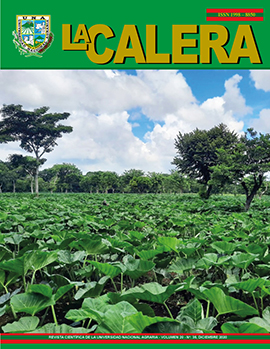Quesungual agroforestry system as a natural source of greenhouse gas emissions in the Tecomapa micro-basin, Somotillo-Nicaragua
DOI:
https://doi.org/10.5377/calera.v20i35.10217Keywords:
methane, nitrous oxide, climate changeAbstract
In order to evaluate the emissions of methane and nitrous oxide in the soil through the closed static chamber method in three systems of use; secondary forest, Quesungual agroforestry system and traditional agricultural system, in the Tecomapa micro basin, Somotillo, Nicaragua, seventy-two closed static chambers were established in six farms located in the Tecomapa hydrographic unit, Nicaragua in 2014, to evaluate the emissions of Methane (CH4) and Nitrous Oxide (N2O), in the land use systems: Secondary forest, Quesungual and Traditional agricultural systems. As a result, higher N2O and CH4 emissions were observed in the rainiest month (September 2014). The Quesungual system was CH4 sinks at the level of accumulated net flows (p> F = 0.0133), and the traditional system was the largest emitter of this gas. The greatest emission of N2O tends to occur in the traditional system. Finally, methane gas was positively associated with N2O (r2 = 1; p> F = 0.0533), and WFPS tends to be negatively associated with temperature and CH4 and N2O gases.
Downloads
497
HTML (Español (España)) 463
EPUB (Español (España)) 186

